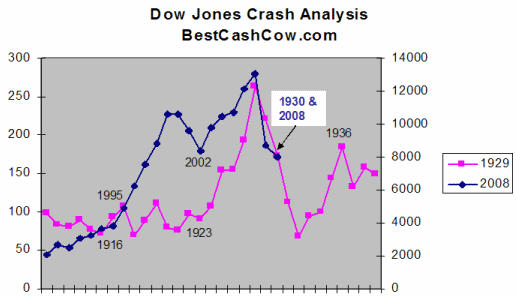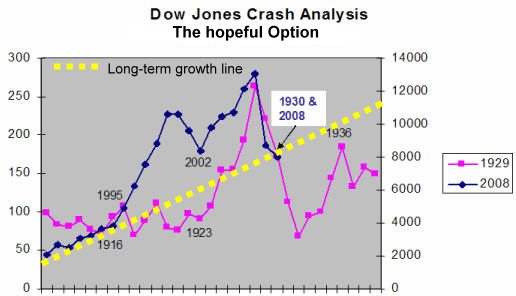 |
Is 2009
a good time to build a
house?
As I write this (Jan. '09) a new president is about to step into the
most perfect economic storm since the great depression. While hope is
high (too high?) that Obama will be able to make bold things happen,
the worldwide financial meltdown is starting to spread to the everyday
economy of jobs and purchasing power.
Can the new president surf his way through this storm and stay on top
of the wave or, are we already in Great Depression 2?
Historical side notes:
- World War One was called the "Great War" until we
entered WW-II
in 1941.
- Many economists say that it was only WW-II that got
us out of GD-I. A chilling thought.
One of the most understandable discussions of what is
going on now, how deep the problems lie, and how they might be repaired
is in "The End of the Financial World as We Know It",
by Michael Lewis and David Einhorn. (An Op-ed essay in the NY Times.)
The chart below shows the build-up of market forces
before and after GD-I compared to where we were in Nov. '08.

"History doesn't repeat itself, but it does
rhyme." Mark
Twain
On the other hand (a
standard phrase of the economic community) we could just be seeing the
markets getting back to their longer term trend lines. We might
overshoot a bit here but can expect to bounce back to the yellow line (hope, hope).

While the stock market
is not the economy, the Dow Jones does do a pretty good job of
predicting the faith of investors in the long-term health of the
business environment. That is why a stock market rise is often the
first sign of a looming recovery.
At
any rate...
Here are some pretty safe
economic bets for 2009:
- Unemployment will rise as businesses adjust to lower
demand for their products and services.
- Borrowing money is likely to continue to be difficult.
- Prices will continue to fall for many of the things
we buy (especially true in housing where prices for materials and labor
are both falling).
Longer-term (it could be several years) prices are almost certainly
going to rise fast once again. This is because of the huge amount of
new money being manufactured now by the Treasury and FED in an attempt
to fight off a depressionary spiral of falling employment, demand and
prices.
When you make excessive New Money you dilute the purchasing power of
Existing Money - this is the definition of inflation and economists,
government and businesses like inflation better than deflation
since
it is something they have more control over.
If you
build in 2009:
While we are going through "a rough patch" as George Bush the younger
used to say, an optimist can easily see a number of advantages to
building in such an
economic environment:
- Materials prices are as much as 50%
less than they were in 2006. Ask for and expect big
discounts. Retailers are eager to keep their inventory moving.
- Construction help, subcontractors and even friends
and family are likely to have more time to help and/or a willingness to
work for less.
- If you are able to work with out-of-pocket cash you
will find your dollars go even further.
- If you are laid off yourself, you may find you make
more working on your house than you did at your old job.
If you build a smaller, energy and space efficient expandable house -
one that uses common materials and simple construction techniques -
then you are perfectly poised to expand the home or sell it at a profit
later when things pick up in the future.
While it is true that home prices may continue to fall a bit more, you
are more likely to be building near the bottom of the market
cycle than at the top. Pity the poor fool who got a 95% loan
to build that 4,000 sf mini-mansion in 2006!
And, should things get even nastier than we now expect, where would you
rather be?
- In a city apartment or a suburban house
- In a more self-sufficient country home with a garden
and woodlot
|
Get Involved with
Building your own Shelter.
There is much to learn about
the design and building of a house (see our Best Books
list). See our article on 5 Ways to
Build a House. You can be an involved owner-builder AND
get help from others! Don't do what doesn't feel right or isn't fun.
Houses are much happier places to live in if the people building it had
FUN (and were therefore flexible, inventive and perhaps even
unconventional - gasp!)
Getting a stock plan that
comes close to meeting your basic space needs and then modifying and
building that
plan with local help is a less expensive alternative to
spending 10% of your total budget on an architect and 20% of the
construction budget on contractor overhead and profit. This is even
before paying yourself for your own work. (See our Building Costs
article.)
Working up an
exciting design that meets your space and budget needs is one of the
first and most important owner-builder projects you will do. It becomes
the foundation of everything that follows. But, don't get too tight
about planning every detail. Opportunities will show up that were not
put down on paper and could not have been anticipated. You need to jump
on these and let the house evolve its own character and direction. Many
of these unanticipated changes will be things people will love about
this house long after you are gone.
We make our plans easy to
customize because we think you will build a better house by staying
awake to opportunities and getting
involved. Here's to FUN and SUCCESS on your project! And don't forget
the Forum. We
are here to help and we love to hear about your project. Check out the Gallery if
you haven't already.
|
|
 |
![]()


